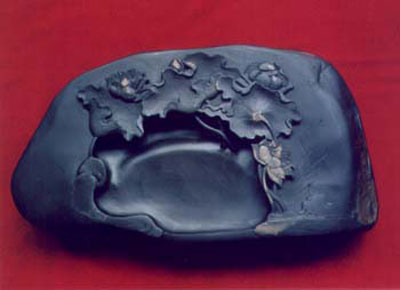 |
|
A inkstone[Photo by Xinhua]
|
Despite this test, one never knew how exquisite an inkstone was until it was used with inksticks and brushes. An inkstick is used to briskly rub an inkstone with a bit of water and then thickened ink quickly comes out floating into the well. Since the surface is delicate it doesn’t hurt the tender hair of the brushes.
The so-called four famous inkstones are considered the best in the country. Duan inkstones are produced in Zhaoqing, Guangdong Province; she inkstones are made in She County, Anhui Province; tao inkstones are from Taozhou, Gansu Province; and chengni inkstones are made of ceramic in Luoyang, Henan Province.
Among all the four treasures in a scholar’s studio, inkstones have the highest value to collectors as they retain their usefulness over a long period of time.
Su Yijian, a politician from the Song Dynasty, once described finding the right inkstone as “god-given fate” and that once you found one “it will accompany you until the day you die.” This sums up how many inkstone collectors and artists feel, even today.
Regarded as one of the four greatest calligraphers in the Song Dynasty, Mi Fu was obsessed with inkstones. When the then Emperor Huizong asked him to leave his calligraphy work on the screen for him, the calligrapher became fond of the emperor’s inkstone.
After finishing his work, Mi knelt and held the inkstone in front of his chest. He said to Huizong: “The inkstone has been defiled by me so it is no longer qualified to be used by the emperor.” Huizong laughed and gave it to him.
Curator Han says many ancient poems were dedicated to inkstones. They originated in China. The earliest excavated one dates from the 3rd century BC and was discovered in a tomb in Hubei Province. Back then ink was made of powdered carbon and came in small balls. Thus, people used a pestle to pulverize the ink ball on the plate-like stone.
Before paper was invented in the late Han Dynasty (206 BC-AD 220 AD), people wrote on bamboo strips or wood. “The handwriting was small. So the earliest inkstones fit in your palm,” Han says.
The development of the written language led to bigger inkstones, according to Han. When Cai Lun invented the paper in about 105 BC, people had more space to write or draw a picture. Hence, bigger inkstones with a well became more popular.
The grinding surface swells in the middle of the round inkstone and is encircled with circular sinks to store ink — Piyong inkstone was produced with the development of paper-making and for more particle use.
Piyong is the highest education institution in Western Zhou (1046-771 BC) for aristocrats during that time. The inkstone imitates its architecture style.
“The craftsmanship and culture of inkstones peaked in the Tang (AD 618-907) and Song dynasties as Chinese culture and civilization flourished,” Han says. “From the exquisite carving of the inkstone to elaborately designed boxes, it’s all very fascinating.”
But during the 1950s, inkstones were considered a sign of decadence and production almost ceased until they later came back in style.
“While in the modern world they are no longer as useful as before, many collectors and businessmen are still interested in the hobby,” says Han.
